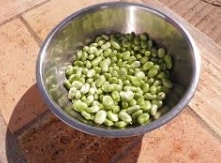The etymological origin of the term bean we have to establish that it is found in Latin. Specifically, it comes from the word “faba”, which means “bean”.
The term refers to a herbaceous plant that belongs to the papilionaceae family group and to the seed and fruit that this plant species produces, which are edible.
 As a papilionaceae, the bean is phanerogamous (its reproductive organs can be seen since they are shaped like a flower), angiosperm (its carpels make up an ovary that shelters the ovules) and dicotyledonous (its embryos have two cotyledons). It has a stem that can measure about one meter, green or bluish leaves, pinkish or whitish flowers , and fruit in a pod with flattened, oblong seeds.
As a papilionaceae, the bean is phanerogamous (its reproductive organs can be seen since they are shaped like a flower), angiosperm (its carpels make up an ovary that shelters the ovules) and dicotyledonous (its embryos have two cotyledons). It has a stem that can measure about one meter, green or bluish leaves, pinkish or whitish flowers , and fruit in a pod with flattened, oblong seeds.
The edible seeds of broad beans weigh one or two grams and usually have a yellowish-green hue that darkens over time . However, there are varieties of beans that exhibit other colors.
Beans are a source of carbohydrates , potassium, phosphorus, magnesium and vitamin A, among other nutrients. They are generally consumed as legumes and used to prepare stews and stews .
These characteristics are why more and more people include beans in their diet. However, they also do so because they have these other significant properties:
-They are very rich in fiber, so they allow you to go to the bathroom frequently.
-They have good levels of folic acid, which, among other things, helps prevent anemia.
-They strengthen the health of the heart and also the bones.
-They protect what is the functioning of the nervous system.
Also called beans , broad beans are native to Central Asia and the Mediterranean area , although they are currently grown in different parts of the planet . Ethiopia , Egypt , China and Australia are the largest producers worldwide.
The plant can grow in practically any type of soil , although it prefers those with a pH between 6 and 7.5 and good drainage. The ideal temperature for its growth is around 15º C and it needs a lot of humidity.
In the field of literature, the term in question has also been used to give the title to a work. This would be the case of the children's book “Jack and the Beanstalk”, also known as “Jack and the Beanstalk”.
It is a story of English origin from oral tradition that, at the beginning of the 19th century, was rewritten by Benjamin Tabart. It tells the story of a boy who decides to sell his cow for some magic beans that, when they grow, become a giant plant that reaches up to the clouds for him to climb. By doing so he will arrive at a castle, where an ogre lives, and where the boy decides to steal some gold coins and a hen that lays golden eggs in order to stop him and his mother from going through economic hardship.
